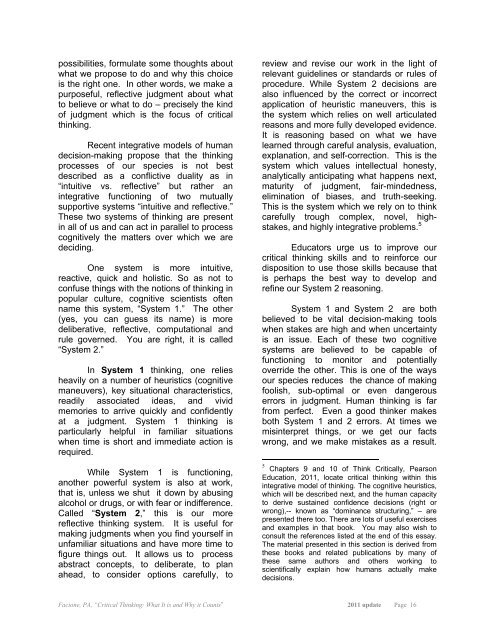Interpreting The Facts
Interpreting The Facts
Interpreting The Facts
You also want an ePaper? Increase the reach of your titles
YUMPU automatically turns print PDFs into web optimized ePapers that Google loves.
possibilities, formulate some thoughts about<br />
what we propose to do and why this choice<br />
is the right one. In other words, we make a<br />
purposeful, reflective judgment about what<br />
to believe or what to do – precisely the kind<br />
of judgment which is the focus of critical<br />
thinking.<br />
Recent integrative models of human<br />
decision-making propose that the thinking<br />
processes of our species is not best<br />
described as a conflictive duality as in<br />
“intuitive vs. reflective” but rather an<br />
integrative functioning of two mutually<br />
supportive systems “intuitive and reflective.”<br />
<strong>The</strong>se two systems of thinking are present<br />
in all of us and can act in parallel to process<br />
cognitively the matters over which we are<br />
deciding.<br />
One system is more intuitive,<br />
reactive, quick and holistic. So as not to<br />
confuse things with the notions of thinking in<br />
popular culture, cognitive scientists often<br />
name this system, “System 1.” <strong>The</strong> other<br />
(yes, you can guess its name) is more<br />
deliberative, reflective, computational and<br />
rule governed. You are right, it is called<br />
“System 2.”<br />
In System 1 thinking, one relies<br />
heavily on a number of heuristics (cognitive<br />
maneuvers), key situational characteristics,<br />
readily associated ideas, and vivid<br />
memories to arrive quickly and confidently<br />
at a judgment. System 1 thinking is<br />
particularly helpful in familiar situations<br />
when time is short and immediate action is<br />
required.<br />
While System 1 is functioning,<br />
another powerful system is also at work,<br />
that is, unless we shut it down by abusing<br />
alcohol or drugs, or with fear or indifference.<br />
Called “System 2,” this is our more<br />
reflective thinking system. It is useful for<br />
making judgments when you find yourself in<br />
unfamiliar situations and have more time to<br />
figure things out. It allows us to process<br />
abstract concepts, to deliberate, to plan<br />
ahead, to consider options carefully, to<br />
review and revise our work in the light of<br />
relevant guidelines or standards or rules of<br />
procedure. While System 2 decisions are<br />
also influenced by the correct or incorrect<br />
application of heuristic maneuvers, this is<br />
the system which relies on well articulated<br />
reasons and more fully developed evidence.<br />
It is reasoning based on what we have<br />
learned through careful analysis, evaluation,<br />
explanation, and self-correction. This is the<br />
system which values intellectual honesty,<br />
analytically anticipating what happens next,<br />
maturity of judgment, fair-mindedness,<br />
elimination of biases, and truth-seeking.<br />
This is the system which we rely on to think<br />
carefully trough complex, novel, highstakes,<br />
and highly integrative problems. 5<br />
Educators urge us to improve our<br />
critical thinking skills and to reinforce our<br />
disposition to use those skills because that<br />
is perhaps the best way to develop and<br />
refine our System 2 reasoning.<br />
System 1 and System 2 are both<br />
believed to be vital decision-making tools<br />
when stakes are high and when uncertainty<br />
is an issue. Each of these two cognitive<br />
systems are believed to be capable of<br />
functioning to monitor and potentially<br />
override the other. This is one of the ways<br />
our species reduces the chance of making<br />
foolish, sub-optimal or even dangerous<br />
errors in judgment. Human thinking is far<br />
from perfect. Even a good thinker makes<br />
both System 1 and 2 errors. At times we<br />
misinterpret things, or we get our facts<br />
wrong, and we make mistakes as a result.<br />
5 Chapters 9 and 10 of Think Critically, Pearson<br />
Education, 2011, locate critical thinking within this<br />
integrative model of thinking. <strong>The</strong> cognitive heuristics,<br />
which will be described next, and the human capacity<br />
to derive sustained confidence decisions (right or<br />
wrong),-- known as “dominance structuring,” – are<br />
presented there too. <strong>The</strong>re are lots of useful exercises<br />
and examples in that book. You may also wish to<br />
consult the references listed at the end of this essay.<br />
<strong>The</strong> material presented in this section is derived from<br />
these books and related publications by many of<br />
these same authors and others working to<br />
scientifically explain how humans actually make<br />
decisions.<br />
Facione, PA, “Critical Thinking: What It is and Why it Counts” 2011 update Page 16

















